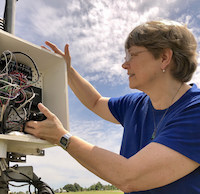University of Georgia agricultural climatologist Pam Knox has been named interim director of the Georgia Automated Environmental Monitoring Network. As interim director, she will oversee the UGA weather network, which includes 86 weather stations statewide.
Every second, each station monitors:
- Air temperature.
- Relative humidity.
- Rainfall.
- Solar radiation.
- Wind speed and direction
- Soil temperature at depths of 2, 4 and 8 inches.
- Atmospheric pressure.
- Soil moisture.
Data from the stations are summarized at 15-minute intervals, and at midnight, a microcomputer on the UGA Griffin campus calculates a daily summary. This data can be accessed on the weather network’s website at weather.uga.edu.
“The weather network is used by a great variety of people in the agricultural industry to keep track of growing degree days or chill hours. Chill hours are especially important for peach growers, as peaches require a number of these hours to bloom properly. If they don’t get them, farmers have to spray chemicals to mature the trees,” Knox said. “Corn growers use the weather data to determine when to apply pesticides to fight fungal diseases.”
The National Weather Service uses the weather network precipitation data to create the drought monitor map that they release every Thursday, Knox said. They also use current wind and rainfall data to identify severe weather in progress.
In addition to those in the agricultural industry, utility companies use the UGA weather network, established in 1991, to help them determine when maximum loads will occur.
“They need to know the hottest and coldest parts of the day to prepare for power usage,” Knox said.
Average people who are interested in weather and students who are learning about weather use the stations, too. Knox was once one of those students.
“I became interested in the weather when I was in the third grade and a tornado came three blocks from my house,” she said. “In college, I was into physics and I got my master’s degree in meteorology from the University of Wisconsin-Madison.”
Knox came to UGA in 2001 and worked alongside David Stooksbury, UGA agricultural engineer and former state climatologist. Since 2012, Knox has worked as an agricultural climatologist in the UGA College of Agricultural and Environmental Sciences.
“Some of the projects I have been doing over the past five to six years have been granted-funded projects on agriculture and climate variability and how climate affects crops and livestock,” Knox said.
Before coming to Georgia, Knox was the Wisconsin state climatologist. Over her career, she has worked with numerous weather observation systems and cooperated with the National Weather Service and other state and federal offices.
As interim director of the weather network, Knox doesn’t plan to make many changes. She will leave those decisions for the permanent director. She does foresee the addition of more weather stations to the network.
“We need to grow smartly and manage the weather network closely to maintain quality control,” she said.
Through a grant with the Southeast Regional Climate Hub, she will study climate variability and its effect on farmers in the Southeast.
“La Nina, El Nino, drought, trends in climate — I look at how these affect farmers,” she said. “The weather dictates how they schedule their field work, pest spraying, which crops to plant and the best time to plant them.”
Knox also writes the UGA climate blog, Climate and Agriculture in the South East, found at blog.extension.uga.edu/climate, to communicate research articles and climate summaries to Georgia and the Southeast.
“I share articles related to climate and agriculture, and I have about 100 followers on Twitter and followers on Facebook,” she said. “It’s not a huge blog, but people do send me comments.
I enjoy doing it and, fortunately, I have a lot of colleagues who send me articles to share.”
Knox is also the coordinator for Georgia’s Region One and Region Three in the Community Collaborative Rain, Hail and Snow Network (CoCoRaHS), a group of citizen scientists who collect and record precipitation observations. The program began in Colorado in 1997 and has since spread across the U.S.
“It’s a bunch of volunteers who report rainfall and some snowfall. Many volunteers are so faithful, they even report zeros when there is no rain,” she said. “They have been important in tracing the high floods across the states. In 2009, the largest amount of rainfall — 15 inches in just a few hours — was recorded near Douglasville, (Georgia). A number of farmers are in that group as well.”
To learn more about CoCoRaHS, visit cocorahs.org.







